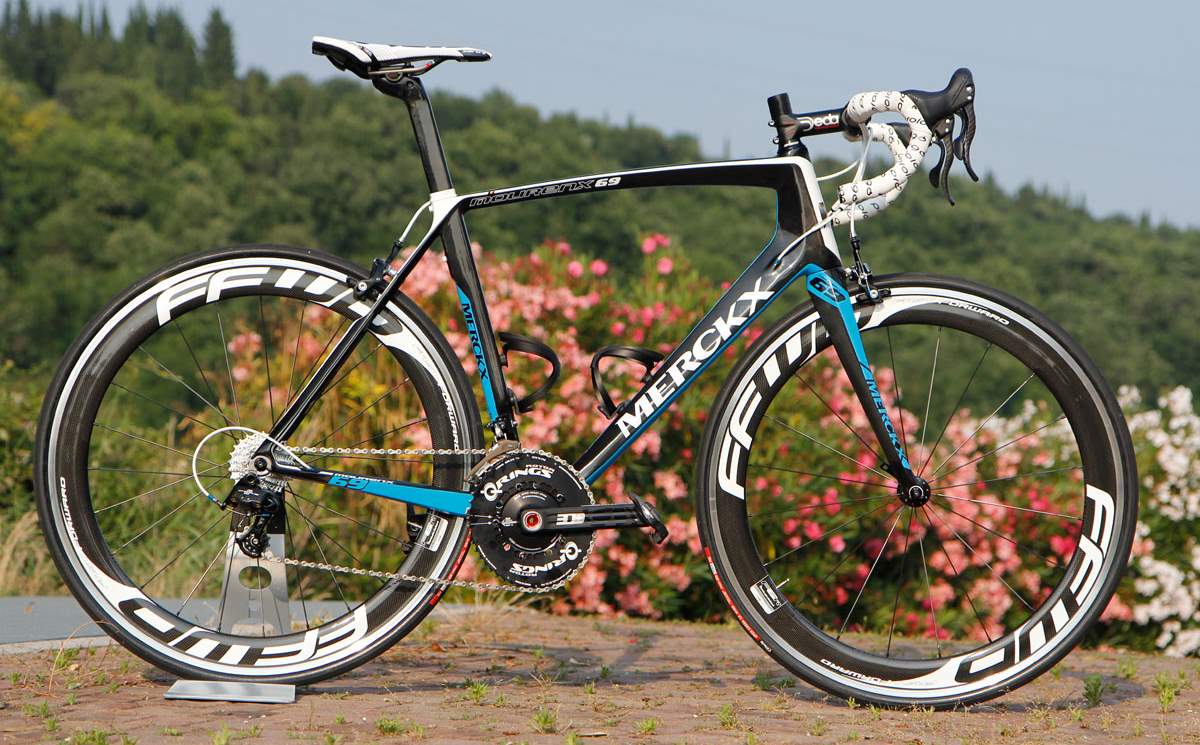Eddy Merckx Bicycles revealed two new road bike models named Mourenx 69 and San Remo 76. Both bikes take engineering and aesthetic cues from last year’s EMX 525, but with lower modulus carbons and cheaper drivetrain and components.
Mourenx 69

The frameset of Mourenx69 weighs 1055 grams. With a slightly higher head tube, longer top tube and stays, it is an endurance bike, it aims to create a relaxed, forgiving position on longer rides.
The name
The 1969 Tour de France was the first which Eddy Merckx won (he won 5 tours in total).
He won the 17th stage, over four cols from Luchon to Mourenx, a commune in the Pyrénées-Atlantiques department in south-western France, by eight minutes after riding alone for 140 km. He climbed the col du Tourmalet in a small group including Roger Pingeon and Raymond Poulidor, having dropped Felice Gimondi. On the final bend to the summit, Merckx attacked and opened a few seconds. By the foot of the Col d’Aubisque he had more than a minute and by the top eight minutes. He maintained the pace for the remaining 70 km to Mourenx, an industrial town near Pau.
He won the general classification (yellow jersey), points classification (green jersey), and the mountains classification. No other rider has achieved this triple in the Tour de France so far.
The Mourenx 69 was specially designed for those who dare to break away from the pack and have the strength to persevere. This endurance racing machine is carefully crafted for cyclists who are set to climb challenging cols such as the Tourmalet or the Aubisque. Rightfully, it is named after one of Eddy Merckx’s spectacular victories in the Tour de France of 1969.
San Remo 76

The San Remo 76 is a more aggressive bike than Mouren 69. The frameset of San Remo 76 weighs 1122 grams.
The name
Friday 19 March 1976: the 67th Milan-San Remo was won for a record seventh time by Eddy Merckx of the Molteni team.
Eddy Merckx, along with Gianbattista Baronchelli, Walter Godefroot, Gerrie Knetemann, Michel Laurent, Luc Leman, Rik Van Linden, Freddy Maertens, Francesco Moser, Wladimiro Panizza, Walter Planckaert, Patrick Sercu, Jean-Luc Vandenbroucke, Roger De Vlaeminck, and Wilfried Wesemael, was part of a leading group of fifteen riders that formed on the descent of the Capo Berta which came after the 240 km mark. Along the rolling coast road, Merckx attacked three times.
Each time he caught the rest of the group by surprise with bursts of effort that took him up to 100 meters clear. Each time his rivals fought back up to him, but having to dig deep into their reserves of strength. Then suddenly the race route turned right off the wide coastal road and onto the narrower road of the Poggio climb. Here came the fourth and vital attack. Again it was a surprise move but this time there was hesitation. De Vlaeminck (Brooklyn) and Maertens (Flandria) looked at each other, hoping the other would bridge the gap. Instead, it was a young Vandenbroucke (Peugeot-Esso-Michelin) who crossed and joined Merckx.
The two Belgians climbed side by side and at the top, it was clear the victory would be between these two. “Eddy asked me to do my share but I had to confess that I was virtually at the end of my strength.” Vandenbroucke said later. At the top, the nearest, Paris-Nice winner Laurent (Miko-De Gribaldy), was 15 seconds behind followed by Panizza (SCIC) with the rest not far back. Merckx had out-witted his rivals once again for most had been expecting an attack over the top of the Poggio, a scene of several of his winning moves in the past.
Into San Remo itself, Vandenbroucke took over the lead from Merckx who motioned him through. With 300 meters remaining Merckx erupted from Vandenbroucke’s back wheel and the race was over. On the descent of the Poggio, only Panizza could get by Laurent who stayed just clear of the sprint won by Planckaert (Maes-Pils-Rokado) from Van Linden (Bianchi) and Sercu (Brooklyn).
Sources
- 1976 Milan-San Remo on Wikipedia
- Top 18 fastest Paris-Roubaix editions - April 7, 2024
- Col de Tourmalet [Amazing photo from the 1953 Tour de France] - January 11, 2024
- Bernard Hinault and Francesco Moser, 1981 Paris-Roubaix - December 8, 2023


